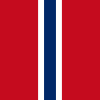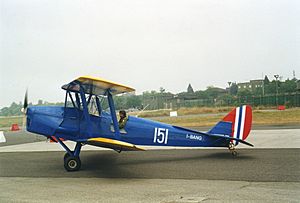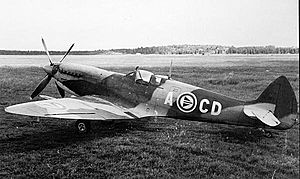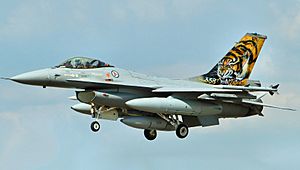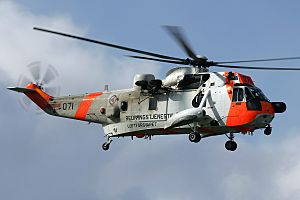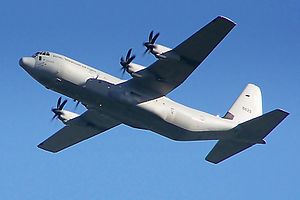Royal Norwegian Air Force facts for kids
Quick facts for kids Royal Norwegian Air Force |
|
|---|---|
| Luftforsvaret | |
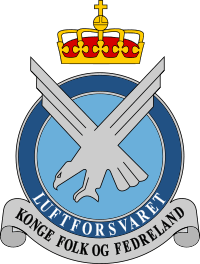
Badge of the Royal Norwegian Air Force
|
|
| Founded | 10 November 1944 |
| Country | |
| Allegiance | Kingdom of Norway |
| Type | Air force |
| Role | Aerial warfare |
| Size |
|
| Part of | Norwegian Armed Forces |
| Headquarters | Rygge Air Station |
| Motto(s) |
|
| Commanders | |
| Commander-in-Chief | HM King Harald V |
| Chief of the Air Force | Major General Rolf Folland (11 August 2021 – present) |
| Insignia | |
| Roundel |   |
| Aircraft flown | |
| Electronic warfare |
Dassault Falcon 20 |
| Fighter | F-35 |
| Helicopter | AW 101, Sea King, Bell 412, NH90 |
| Patrol | P-3 Orion |
| Trainer | Saab Safari |
| Transport | C-130J-30 |
The Royal Norwegian Air Force (RNoAF), also known as Norwegian: Luftforsvaret (meaning "The Air Defence"), is Norway's official air force. It became a separate part of the Norwegian Armed Forces on November 10, 1944. The RNoAF has about 2,430 full-time staff, including officers and civilians. Another 600 people serve their required military time. If needed, the RNoAF can grow to about 5,500 people.
The RNoAF uses seven main airbases across Norway. These are located at Ørland, Rygge, Andøya, Evenes, Bardufoss, Bodø, and Gardermoen. There is also a control center in Sørreisa and three training centers. These training centers are in Værnes near Trondheim, Kjevik in Kristiansand, and at KNM Harald Haarfagre/Madlaleiren in Stavanger.
Contents
History of the Royal Norwegian Air Force
Early Days of Flight in Norway
Military flights in Norway began on June 1, 1912. The very first plane was named HNoMS Start. It was bought with money donated by the public. Hans Dons, who was second in command of Norway's first submarine, HNoMS Kobben (A-1), was its pilot. Before 1940, most planes used by the Navy and Army air forces were designed in Norway or built under special agreements. For example, the Army's main bomber was the Dutch-designed Fokker C.V.
World War II and the Air Force
Preparing for War
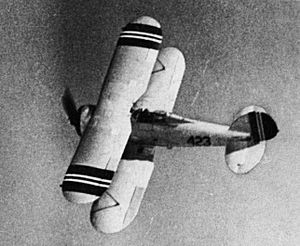
Before 1944, Norway's air forces were split into two parts. These were the Norwegian Army Air Service and the Royal Norwegian Navy Air Service.
In the late 1930s, as war seemed likely, Norway bought more modern planes from other countries. These included twelve Gloster Gladiator fighter planes from the UK. They also bought six Heinkel He 115 planes from Germany. Many more aircraft were ordered from US companies just before Germany invaded Norway on April 9, 1940.
A very important order was for 24 Curtiss P-36 Hawk fighter planes. Nineteen of these arrived before the invasion. However, none were ready for combat when the attack happened. Some were still in their shipping boxes in Oslo. Others were at the Kjeller aircraft factory, ready to fly but not ready for battle. Some planes at Kjeller did not even have machine guns installed.
The ship carrying the last five P-36s meant for Norway was sent to the United Kingdom instead. The Royal Air Force (RAF) took these planes. The 19 Norwegian P-36s captured by Germany were later sold to the Finnish Air Force. Finland used them well during the Continuation War.
Another order was for 36 Hawk 75A-8 planes. None of these arrived before the invasion. They were delivered to "Little Norway" in Canada. There, they were used to train Norwegian pilots. Later, the USAAF took them over.
Norway also ordered 24 Northrop N-3PB float planes. These were built to Norwegian needs for a patrol bomber. The order was placed on March 12, 1940. The goal was to replace older patrol planes. None were delivered by April 9. When they became ready, they were used by the 330 (Norwegian) Squadron in Reykjavík, Iceland. They helped protect ships and hunt submarines.
Escape and Life in Exile
Norway's air forces were quickly defeated because they were much smaller. However, seven Gladiators defended Fornebu airport against German attackers. They successfully shot down two German fighter planes, two bombers, and one transport plane. The Norwegian fighter wing lost two Gladiators on the ground while refueling. One was shot down in the air. After Allied forces left, the Norwegian Government stopped fighting in Norway. They moved to the United Kingdom on June 10, 1940.
Only planes from the Royal Norwegian Navy Air Service could fly all the way to the UK. These included four German-made Heinkel He 115 seaplane bombers. Six were bought before the war, and two more were captured from the Germans. One He 115 also escaped to Finland. Three M.F. 11s also landed in Finland. A captured German Arado Ar 196 plane was also flown to Britain for testing.
For the Norwegian Army Air Service planes, the only escape was to Finland. There, the planes would be held but not fall into German hands. Two Fokker C.V.s and one de Havilland Tiger Moth made it to Finnish airfields. All planes that fled to Finland were used by the Finnish Air Force. Most of the aircrew eventually went to "Little Norway."
The Army and Navy air services set up in Britain. Norwegian air and ground crews worked with the British Royal Air Force. They were in both Norwegian squadrons and other units. Norwegian personnel flew two squadrons of Supermarine Spitfires: No. 331 (Norwegian) Squadron and RAF No. 332 (Norwegian) Squadron. The Norwegian government in exile paid for the planes and their running costs.
In the autumn of 1940, a Norwegian training center called "Little Norway" was built. It was located near Toronto Island Airport in Canada.
The Royal Norwegian Air Force (RNoAF) was officially created on November 1, 1944. This merged the Army and Navy air forces into one. No. 331 (Norwegian) Squadron defended London from 1941. It was the most successful fighter squadron in South England during the war.
By May 8, 1945, 335 people had died while serving in the RNoAF.
After the War
After World War II, the Spitfire planes continued to be used by the RNoAF into the 1950s.
In 1947, the RNoAF got its first radar system. Around the same time, they received their first jet fighters, the de Havilland Vampires.
In 1949, Norway helped start NATO. Soon after, they received American aircraft through the Military Aid Program (MAP). The Air Force grew very quickly as the Cold War developed. During the Cold War, the Norwegian Air Force was one of only two NATO air forces that shared a land border with the Soviet Union. Norwegian fighter planes intercepted Soviet aircraft about 500–600 times each year.
In 1959, the Anti-Aircraft Artillery became part of the Royal Norwegian Air Force.
In 1999, Norway sent six F-16s to participate in the NATO bombing of Yugoslavia.
The RNoAF in the 21st Century
In October 2002, a group of 18 F-16 fighter-bombers from Norway, Denmark, and the Netherlands flew to Manas Air Base in Kyrgyzstan. They supported NATO ground forces in Afghanistan as part of Operation Enduring Freedom. One of their missions was called Operation Desert Lion.
On January 27–28, Norwegian F-16s bombed Hezb-e Islami Gulbuddin fighters in the Adi Ghar Mountains. This was at the start of Operation Mongoose.
In 2004, four F-16s took part in NATO's Baltic Air Policing operation.
Since February 2006, F-16s from the Netherlands and Norway have supported NATO troops in Afghanistan. This air group is known as the 1st Netherlands-Norwegian European Participating Forces Expeditionary Air Wing.
2010s Missions
In 2011, some F-16s were sent to help enforce the Libyan no-fly zone. Norway's Foreign Minister, Jonas Gahr Støre, spoke out against violence in Libya. He said protests show people want more democracy. The government must respect human rights. He stressed the need for peaceful talks. On March 19, 2011, Norway approved sending the Royal Norwegian Air Force to Libya.
Norway sent six F-16 fighters and personnel. They started their mission on March 21. They operated from the Souda Air Base on Crete.
On March 24, 2011, RNoAF F-16s were assigned to the United States Africa Command for Operation Odyssey Dawn. The next day, Norwegian F-16s used laser-guided bombs against Libyan tanks. During the night of March 26, an airfield was bombed. Forces also joined Operation Unified Protector on March 26, 2011.
By July 2011, Norwegian F-16s had dropped almost 600 bombs. This was about 17% of all bombs dropped at that time. On the night of April 26, Norwegian F-16s bombed Gaddafi's headquarters in Tripoli.
From September to December 2011, the Air Force sent personnel and one P-3 Orion plane to Operation Ocean Shield. Operating from the Seychelles, the aircraft searched for pirates in the Somali Basin.
In April 2016, an Air Force F-16 jet saved a patient's life in Bodø. It quickly flew special medical equipment halfway across Norway in less than 30 minutes.
On March 29, 2017, Norway signed a contract for five P-8A planes. These were to be delivered between 2022 and 2023.
On November 3, 2017, the RNoAF received its first F-35A Lightning II fighter jet.
2020s Developments
In March 2021, the RNoAF took part in Icelandic Air Policing. They used four F-35A Lightning II jets and 130 military staff.
On December 2, 2021, the RNoAF announced that twelve F-16As had been sold to Draken International. This transfer was expected in 2022, after approval from the US and Norwegian governments. In December 2021, Romania also showed interest in buying the remaining 32 F-16As.
On January 6, 2022, the F-35 officially took over the Quick Reaction Alert mission. This ended the F-16 fleet’s 42-year mission in that role.
Future Plans
In 2016, Norway began looking into the Boeing P-8A Poseidon MMA. This plane would replace the older P-3C Orion and Falcon 20 aircraft by 2020-2025. In November 2016, Norway confirmed its plan to buy five of these planes. On March 5, 2018, the United States Department of Defense announced a contract with Boeing for five P-8A Poseidons for the RNoAF.
How the Air Force is Organized
The RNoAF is divided into five Air Wings. These include one Control and Reporting Centre and nine flying squadrons. There are also two ground-based air defense units. The old names for air stations have changed. Now, they are called Air Force Stations (flystasjon) and Air Force Bases (Luftforsvarets base).
- 131 Air Wing, based in Sørreisa
- Control and Reporting Centre Sørreisa, which reports to NATO's Integrated Air Defense System in Germany.
- Radar Station Njunis, with RAT-31SL/N radar.
- Radar Station Senja, with RAT-31SL/N radar.
- Radar Station Honningsvåg, with RAT-31SL/N radar.
- Radar Station Vestvågøy, with SINDRE I radar.
- Radar Station Vågsøy, with SINDRE I radar.
- Radar Station Skykula, with SINDRE I radar.
- Control and Reporting Centre Sørreisa, which reports to NATO's Integrated Air Defense System in Germany.
- 132 Air Wing (132 Luftving), with its main office at Ørland Air Station.
- Ørland Air Station (Ørland flystasjon)
- 331 Squadron (331 Skvadron), flying F-35A Lightning II jets.
- 332 Squadron (332 skvadron), flying F-35A Lightning II jets.
- Testing, Training and Tactics Development Squadron (Testing, trening og taktikk skvadron), also with F-35A Lightning II jets.
- Aircraft Maintenance Group Ørland (Vedlikeholdsgruppen Ørland).
- Air Defence Battalion NASAMS III (Luftvernbataljonen NASAMS III).
- Base Defense Squadron (Baseforsvarsskvadron).
- Base Operations Group Ørland (Basegruppen Ørland).
- Air Force Logistical Base (Logbase Luft).
- NATO Airborne Early Warning Force – Forward Operating Location, for E-3A Sentry planes.
- Ørland Air Station (Ørland flystasjon)
- 133 Air Wing, with its main office at Evenes Air Station. This unit moved from Andøya Air Station.
- Evenes Air Station (Evenes flystasjon) - The 333 Squadron will move here with the new P-8A Poseidon planes. This air station will also be a forward base for the F-35A fighters. As Evenes grows, it will have its own air defense unit and base defense squadron. When fully ready, the base will include:
- Evenes Staff Unit (Stab Evenes).
- 333 Squadron (333 skvadron), planning to use 5 Boeing P-8A Poseidon aircraft starting in 2023. These planes will be used for ASW (hunting submarines), maritime patrol, and electronic warfare.
- Aircraft Maintenance Squadron (Vedlikeholdsskvadron).
- Air Defence Battery (Luftvernbatteri).
- Base Defence Squadron (Baseforsvarsskvadron).
- Base Operations Squadron (Baseskvadron).
- Base [Staff] Department (Baseavdeling).
- Andøya Station Group (Stasjonsgruppe Andøya) at Andøya Air Force Base (Luftforsvarets base Andøya).
- 333 Squadron, currently with P-3C/N planes for ASW and other roles. This unit will move to Evenes Air Base, and Andøya will close as an air base in 2023.
- Evenes Air Station (Evenes flystasjon) - The 333 Squadron will move here with the new P-8A Poseidon planes. This air station will also be a forward base for the F-35A fighters. As Evenes grows, it will have its own air defense unit and base defense squadron. When fully ready, the base will include:
- 134 Air Wing, at Rygge Air Station.
- Rygge Air Station (Rygge flystasjon)
- 339 Special Operations Aviation Squadron (339 skvadron), using Bell 412 SP helicopters to support special forces.
- Special Operations Air Task Group.
- Gardermoen Station Group (Stasjonsgruppe Gardermoen) at Air Force Base Gardermoen (Luftforsvarets base Gardermoen). This is the military part of Oslo - Gardermoen IAP. (The 135th Air Wing was closed in August 2018 and joined the 134th Air Wing.)
- 335 Squadron (335 skvadron), flying C-130J-30 Super Hercules transport planes.
- 717 Squadron (717 skvadron), using DA-20 planes for electronic warfare and VIP transport.
- Armed Forces Center for Electronic Warfare (Forsvarets elektroniske krigføringssenter (FEKS)).
- Rygge Air Station (Rygge flystasjon)
- Maritime Helicopter Wing (Maritim helikopterving), with its main office at Bardufoss Air Station.
- Bardufoss Air Station (Bardufoss flystasjon)
- 337 Squadron (337 skvadron), flying NHIndustries NH90NFH helicopters. This is also known as the Coast Guard Squadron (Kystvaktskvadronen), as the helicopters help the Norwegian Coast Guard.
- Air Force Flying School (Luftforsvarets flygeskole), using MFI-17 Supporter planes.
- Aircraft Maintenance Squadron (Vedlikeholdsskvadron).
- Base Operations Squadron (Baseskvadron).
- Bardufoss Air Station (Bardufoss flystasjon)

-
- Air Force Base Haakonsvern (Luftforsvarets base Haakonsvern). This is the air force part of the Haakonsvern Naval Base (Haakonsvern orlogsstasjon).
- 334 Squadron (334 skvadron), flying NHIndustries NH90NFH helicopters. This is also known as the Frigate [Helicopter] Squadron (Fregattskvadronen), as the helicopters operate from the Fridtjof Nansen-class frigates.
- Station Group Banak (Stasjonsgruppe Banak), at Lakselv Airport.
- Air Force Base Haakonsvern (Luftforsvarets base Haakonsvern). This is the air force part of the Haakonsvern Naval Base (Haakonsvern orlogsstasjon).
- Rescue Helicopter Service (Redningshelikoptertjenesten), with its main office at Stavanger - Sola Air Station. In Norway, air rescue is managed by the Ministry of Justice and Public Security. This ministry also pays for rescue activities and aircraft. The Rescue Helicopter Service is run by the Air Force for the Ministry of Justice. Rescue helicopters are ready to go within 15 minutes.
- 330 Squadron (330 skvadron), performing Search and Rescue missions. They use Sea King helicopters and are bringing in new AgustaWestland AW101 helicopters at Sola Air Station.
- Detachment Banak (detasjement Banak) at Banak Air Force Base.
- Detachment Bodø (detasjement Bodø), at Bodø Air Force Base.
- Detachment Ørland (detasjement Ørland) at Ørland Air Station.
- Detachment Rygge (detasjement Rygge) at Rygge Air Station.
- Detachment Florø (detasjement Florø) at Florø Airport. (This has been operated by CHC Helikopter Service since 2017 while the AW101s are being introduced.)
- Air Force Schools (Luftforsvarets skoler)
- Royal Norwegian Air Force Academy, in Trondheim.
- Air Force Air Operational Training and Certification Center (Luftforsvarets flyoperative trenings- og sertifiseringssenter), previously the Air Force Air Tactical School, at Rygge.
- Air Force Flight Training School (Luftforsvarets flygeskole), at Bardufoss.
- Air Defence Tactical School (Luftverntaktisk skole), at Ørland.
- Air Force Base Defence Tactical School (Luftforsvarets baseforsvarstaktiske skole), at Værnes.
- Air Force Control and Reporting School (Luftforsvarets kontroll- og varslingsskole), at Sørreisa.
- Air Force Flight Technical School (Luftforsvarets tekniske skole), at Kjevik.
- Air Force Specialists School (Luftforsvarets spesialistskole), at Kjevik.
- Air Warfare School (Luftkrigsskolen), at Trondheim. In 2018, this school became part of the Armed Forces Academy and is no longer directly part of the Air Force.
Aircraft Used by the Air Force
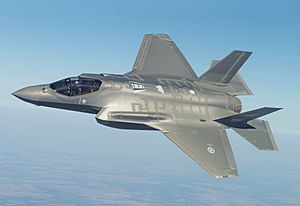
Current Aircraft
| Aircraft | Origin | Type | Variant | In service | Notes |
|---|---|---|---|---|---|
| Combat Aircraft | |||||
| F-35 Lightning II | United States | multirole | F-35A | 24 | 18 more on order |
| Electronic Warfare | |||||
| Falcon 20 | France | electronic warfare | 200 | 2 | |
| Maritime Patrol | |||||
| P-3 Orion | United States | ASW / patrol | P-3C/N | 6 | |
| Boeing P-8 | United States | ASW / patrol | 5 | ||
| Transport | |||||
| Lockheed C-130J | United States | tactical airlift | C-130J-30 | 4 | |
| Helicopters | |||||
| Bell 412 | United States | utility | 18 | ||
| NHIndustries NH90 | European Union | ASW | 13 | 1 on order | |
| Westland Sea King | United Kingdom | SAR / utility | Mk. 43 | 9 | |
| AgustaWestland AW101 | United Kingdom | SAR / utility | 11 | 5 on order - replacing Sea King helicopters | |
| Trainer Aircraft | |||||
| Saab MFI-15 Safari | Sweden | basic trainer | 16 | ||
| F-35 Lightning II | United States | trainer | F-35A | 10 | used for conversion training at Luke AFB |
NOTE: Norway is part of three NATO programs. These programs give them access to an Airbus A330 MRTT tanker plane, 3 C-17 transport planes, and 5 RQ-4 Global Hawk drones.
Retired Aircraft
Planes and helicopters that the Air Force used in the past include:
- General Dynamics F-16 Fighting Falcon
- North American F-86K
- Republic F-84G
- Lockheed F-104 Starfighter
- Northrop F-5
- Lockheed T-33
- Fairchild PT-26
- Catalina PB5Y-A
- Douglas C-47
- DHC-3 Otter
- Noorduyn Norseman
- Cessna O-1
- Bell UH-1B
- Bell 47G helicopter
See also
 In Spanish: Real Fuerza Aérea Noruega para niños
In Spanish: Real Fuerza Aérea Noruega para niños


